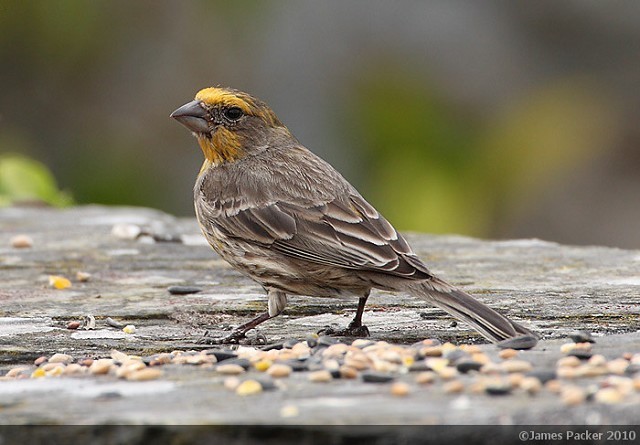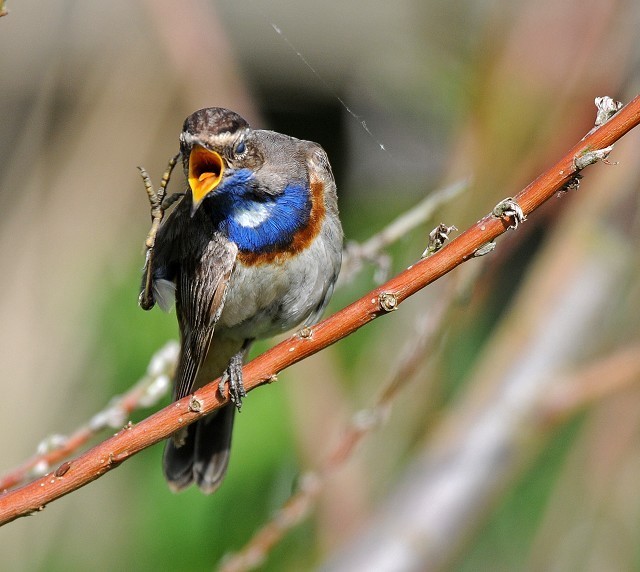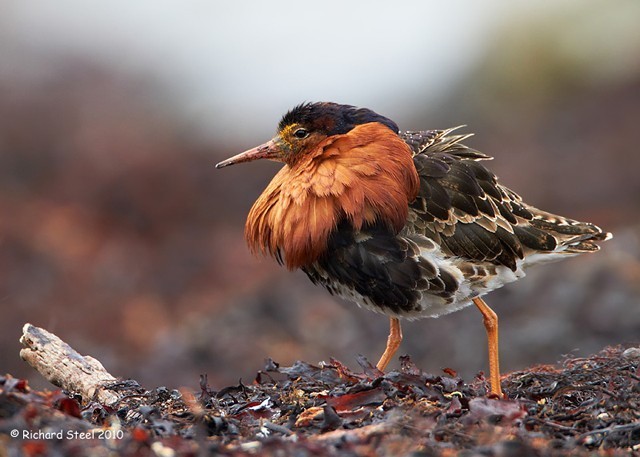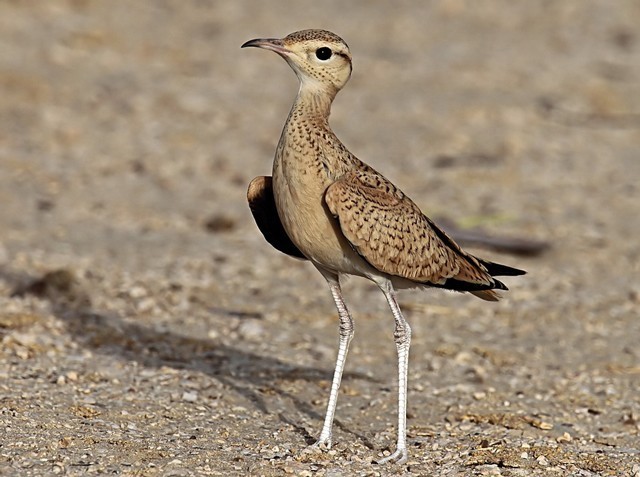The week at a glance
- House Finch in Devon
- Brünnich's Guillemot in Orkney
- 'Dark-rumped' petrel in Devon
- White-throated Sparrow in Lincolnshire
- Little Shearwater still in Devon
With all of the Iberian Chiffchaffs giving up and going home (or not being reported as everyone has seen them now), the week of 'megas' was a bit quieter. There were some highlights, but sadly not exactly twitchable ones!
Arguably the rarest bird of the week, and also remaining the most contentious, was the (presumed) return of the yellow-variant House Finch in the Southwest. The Cornish bird at Land's End was last seen on 12th May, and after an absence of six weeks what must be the same bird turned up in gardens in East Prawle (Dorset) on 27th. With the choice being going to see a finch of dubious origin way down in the southwest or sitting on the sofa watching the national team lose yet again to the Germans, many may now be thinking they made the wrong decision... The bird stayed through to the end of the week though, commuting between various buildings around the village green. The House Finch does make for some good talking points though — or is it typing points these days? Is it more likely to be an escape or a hapless, ship-assisted bird? Do its recent movements support either of the above origins? How migratory is the east-coast population in the USA? Will this record prompt a reassessment of the previous (rather unpublicised) records? These include two spring birds on Fair Isle (Shetland), on 25th May 1962 and a female from 27th–30th April 1966, and a rather vague record from Gazeley (Suffolk) in March 1988.

House Finch, East Prawle, Devon (Photo: James Packer)
Other frustratingly brief reports came from the sea. A summer-plumaged Brünnich's Guillemot was seen from the ferry leaving Lyness on Hoy (Orkney) on the morning of 28th. It didn't spark quite the excitement it should, though, as both observers had spent a very long three days solidly studying their Red-throated Diver population on Hoy! It was rather distant but both observers were confident of its identity (and are familiar with the species), though it couldn't be found when looked for later. This is only the second June record of the species, so for the two lucky observers this was a rare chance to see the species in this plumage. There are seven previous records for Orkney although, apart from one on Sule Skerry in 1991, all of these have been dead, the last at North Ronaldsay Bird Observatory in 2001. This species must vie for the title of the most overlooked rarity (or most difficult ID challenge) in the UK. When you consider that of the 42 accepted records, no fewer than 26 have been found dead, this gives some idea of the number of birds that must be out there somewhere. The last long-staying bird was seen on Lerwick and Bressay (Shetland) over 30th November to 20th December 2005.
Elsewhere, a belated report came in of a dark-rumped petrel seen south of the Eddystone Reef (Devon, or is it Cornwall?) on 23rd. This species is also a bit of an ID challenge, and this could well have been either a Swinhoe's Petrel or a dark-rumped Leach's Petrel.
What weekly review would be complete without mention of a belated report of a Nearctic vagrant in a garden?! This week's offering came in the form of yet another White-throated Sparrow. This bird — and I've lost count how many there have been now (eight?) — was at Fulbeck (Lincolnshire) on 18th–19th June, but not seen since. The record only came to light when a photograph taken through the kitchen window was sent to the chairman of Lincolnshire Bird Club for identification. This is a second for the county, following a bird found in a mist net at Willingham on 5th December 1992, staying until 28th March 1993.
Last but not least, after only just making the weekly review last week, the Little Shearwater on Lundy (Devon) again cut it fine, being reported early in the morning on 24th only.
The drake Blue-winged Teal remained, though was very elusive, at Berry Fen (Cambridgeshire) until 28th, though nobody managed to get any closer to solving the origin of this ringed bird. Also still in residence at the start of the week was the drake Lesser Scaup at Loch Leven (Perth & Kinross) present on 24th. Interestingly, it wasn't seen the next day, but was replaced by three Scaup and a drake Aythya hybrid. The unseasonable Smew was also seen on the Loch on 29th.

Blue-winged Teal, Berry Fen, Cambridgeshire (Photo: Simeon Grundy)
New in was a drake Green-winged Teal, found with Teal on rock pools at St Andrews (Fife) on 28th. Other duck interest came in the form of the female Ferruginous Duck at Minsmere to 28th, the King Eider again at West Burra (Shetland) on 25th and in Aberdeenshire, the drake seen again at Blackdog on 26th.
There was no sign of the weekly Surf Scoter over the weekend, but rather unusual records of inland Common Scoter came from Abberton Reservoir (Essex) on 27th–28th, Martnaham Loch (Ayr) on 29th and a very bizarre record of 11 on Lake Vyrnwy (Powys) on 29th. The inland female Red-breasted Merganser was also still present, at Rainham Marshes until 29th.
The sea was a bit quieter this week (what with all the scoters heading inland!), with the main interest being records of 14 Balearic Shearwaters past Chynhalls Point, Coverack (Cornwall) in the early morning of 28th (along with 150+ Manx Shearwaters), one past Porthgwarra (Cornwall) on 29th (with 200 Manxies), 10 off Gyllyngvase, Falmouth (Cornwall) on 30th and one past Portland Bill (Dorset) on 30th.
The flamingo story continued, but the latest chapter was a late report of a Lesser Flamingo over Ellesmere Port (Cheshire) on 20th. Interestingly, though, a group of five Greater Flamingos at Baie du Somme in northern France on 27th included one bird that was ringed. It had been ringed in the Camargue in 2005, and had subsequently been seen in Portugal from 2006 to 2008, before returning to its natal colony in the Camargue in spring 2010, and then to northern France.
There was just a single record of White Stork, of a bird in a cut hay field at Bodmin (Cornwall) on 24th. The male Little Bittern was reported again, croaking at Walton Heath (Somerset) on 26th–29th, and visiting birders are reminded that they must stick to the paths and follow other on-site instructions. Intriguingly, a small, dark heron, thought to be an immature Night Heron, was seen twice at Trimley St Mary (Suffolk) on 26th but didn't reveal its true identity. More obliging were the Purple Herons at Dungeness (Kent) and the 'Date With Nature' viewing platform will be open at the reserve until 4th July, daily from 11:00–16:00. Aside from these birds, these was a report of one coming in off the sea over the pier at Clacton-on-Sea (Essex) on 28th and one at Handois (Jersey) on 29th.
The only Great White Egrets of the week were at Shapwick Heath (Somerset) on 26th–29th and one with Little Egrets at Great Island (Co Cork) on 29th. There was also a report of a Cattle Egret over Norwich (Norfolk) on 25th though many pairs of eyes (and bins) failed to relocate it.
The resident Glossy Ibis was at Tacumshin (Co Wexford) all week, and there were still plenty of records of Spoonbill coming in. The most notable were nine at Cley Marshes (Norfolk) on 28th, eight at Minsmere (Suffolk) on and off all week and four on the Ythan estuary (Aberdeenshire) all week.
News on Ospreys has been rather mixed, with Scottish birds recovering from illnesses and Welsh birds arriving weeks late! Migrant birds or non-breeders were still being seen, with 13 birds reported, including two at Grindon Lough (Northumberland) for just five minutes on 29th.
On the raptor front, a Black Kite over Cornard Mere (Suffolk) on 30th was probably different to the one over Strumpshaw Fen (Norfolk) on the same day and there was also an unconfirmed report of two birds over hills at Melmerby Fell (Cumbria) on 22nd. There was also just one Red-footed Falcon, a first-summer male at Dungeness (Kent) on 27th.
The two Common Cranes remained on Orkney, reported on a silage field at Outertown on 24th and there was also a single bird at Crosbost, Lewis (Outer Hebrides) on 30th.
We might expect wader numbers to start building up now, but there has been a dearth of rare waders this week. The only highlights were the Terek Sandpiper, which continued to show well from the hide at Rogerstown estuary (Co Dublin) to 26th, and a new arrival in the form of a Pectoral Sandpiper on North Ronaldsay (Orkney) on the morning of 30th. Temminck's Stints were still surprisingly scarce with birds reported from Aberdeenshire and Cleveland. Red-necked Phalaropes were still viewable from the RSPB watchpoint on Lewis, with two present this week, though a bit distant. Elsewhere there was an unconfirmed report of a female at Maxey GP on 27th and male was at Shapinsay (Orkney) on 28th–29th.

Pectoral Sandpiper, North Ronaldsay, Orkney (Photo: Paul A Brown)

Temminck's Stint, Rigifa Pool, Aberdeenshire (Photo: Barry Farquharson)
So-called winter gulls still lingered, with a near-adult Glaucous Gull at Kilrush (Co Clare) on 28th and a juvenile Iceland Gull over Scapa Bay (Orkney) on 25th and a sub-adult at Bull Island (Co Dublin) on 29th. Numbers of Yellow-legged Gulls should be really starting to increase soon, and there were reports from many locations. The peak count was of 12 at Rainham Marshes (London) on 28th, where there was also a Caspian Gull on the same day. The only other Caspian reported was a second-summer at Canvey Island (Essex) on 30th. The most amazing gull story of the week, though. came from Lincolnshire. On the evening of 28th a first-summer Bonaparte's Gull was found near Far Ings (Lincolnshire). This is only the second record for the county and incredibly the finder of this bird also co-found the first county record in 1979 — though has since retracted his description due to poor views of the bird. Also at the roost, and standing almost next to the Bonaparte's, was Lincolnshire's fourth Ring-billed Gull, also a first-summer. To add to the bizarre situation, the first record, in 1988, was again found by the same finder! These two-star birds weren't seen the next morning, although the morning twitch consisted of one sole observer! The Ring-billed Gull did reappear though, coming into the same roost on the evening of 29th. This roost has also recently held up to 10 Mediterranean Gulls and six Yellow-legged Gulls.
The long-staying Forster's Tern was again at Tacumshin (Co Wexford), just squeezing into the weekly summary with a report on 24th. Providing more excitement were two Gull-billed Terns touring the south coast. First seen from the hide at Bowling Green Marsh (Devon) on evening of 28th, they were then seen the next day heading north over the M5 bridge at Topsham. This is almost a repeat occurrence of last year, when a bird commuted between Topsham and Bowling Green Marsh over 23rd May to 1st June. One was then recorded past West Bexington and Chesil Beach (Dorset) on 29th, then two spent most of the day hawking over fields at Abbotsbury on 30th. They may have had a slight detour though, as two birds were seen at Slapton Ley on the same day. To add to the pattern, there was also a report of an adult at Slimbridge (Gloucestershire) early morning on 30th but not after.
Despite the Mediterranean weather, southern birds were rather scarce, with single records of Pallid Swift — reported with 30 Swifts briefly over Carmel Head (Anglesey) on 26th, Bee-eater — on Rathlin Island (Co Antrim) on 27th, Red-backed Shrike — one at Stepper Point (Cornwall) on 30th (following a late report, of a male at Altcar Moss (Lancashire) on 23rd), and Red-rumped Swallow — at Blennerville (Co Kerry) on 27th. The latter is still a rare bird in the county, with the last on Great Blasket in September 2004. Apart from the breeding birds at Lakenheath Fen, there was also just a single Golden Oriole, singing at Ham (London) for an hour on 30th.
The singing male Great Reed Warbler remained at Straw's Bridge (Derbyshire) until 25th and the bird ringed at Malltraeth Marsh (Anglesey) on 15th was still singing on 24th. The singing Marsh Warbler remained at Newchurch (Isle of Wight) to 24th, with others on Whalsay (Shetland) on 26th and in a garden at Ardleigh (Essex) on 29th.
Bringing some colour to the week was an adult Rose-coloured Starling at Porthgwarra (Cornwall) from 24th–28th, visiting the Minack Theatre on 25th, though presumably not to catch a performance of The Doctor's Daughter there ("an intriguing tale of trickery and infatuation").

Rose-coloured Starling, Minack Theatre, Cornwall (Photo: Gordon Hodgson)
The male white-spotted Bluethroat continued to please at Welney to 29th, though has become slightly more elusive, even going unreported for several days. There was also a very unusual report of a bird photographed in a garden in Bristol (Somerset) on 19th. It was present for just 90 minutes, spending time singing, bathing and feeding on suet on a bird table! This caused a flurry of activity on the Forums (again), but after some thorough local checking was proved to be a genuine, if unlikely, record. More details can be found on the Birds of South Gloucestershire website.

Bluethroat, Bristol, Somerset & Bristol (Photo: Janet Farly)
The stunning male Channel Wagtail at Fiskerton Fen (Lincolnshire) is now paired with a Yellow Wagtail, reported on 27th, and the Tawny Pipit remained on the airfield on North Ronaldsay (Orkney) until 26th; the first for the island and only the fourth for Orkney. The male Serin also remained on St Agnes (Isle of Scilly), reported on 24th only.
The photogenic singing male Common Rosefinch at Glendevon (Perth & Kinross) remained until 26th with another belatedly reported singing from a garden at Clay Cross (Derbyshire) on 17th June.
Photo of the Week

Arctic Tern, Farne Islands, Northumberland (Photo:
David Whistlecraft)
At this time of year, bird photographers head to the Farne Islands in Northumberland in their droves, lured by the opportunity to get close to a wide range of breeding seabirds. Most concentrate on the charismatic Puffins, although some branch out into the other speciality species, such as Razorbills, Shags and terns. Not surprisingly, the majority of images coming out of this mass photo-fest tend to look very similar, and it takes considerable creativity to come up with original compositions. Bird photographer David Whistlecraft illustrates how this can be achieved with his monochrome image of an Arctic Tern flying across a characteristic local scene. David used a wide-angle lens to capture the whole scene with sufficient depth-of-field, and 'fill-flash' to bring out detail in the bird. Boosting contrast during processing, especially in the sky, has created a highly dramatic effect very rarely seen in bird photography.
Other notable photos

Puffin, Farne Islands, Northumberland (Photo:
Nigel Pye)

Pheasant, undisclosed site, Cheshire (Photo:
Damian Waters)

Common Swift, Wallingford, Oxfordshire (Photo:
Roger Wyatt)

Swallow, Fleetwood, Lancashire (Photo:
David Moreton)

Bluethroat, Welney WWT, Norfolk (Photo:
Jon Evans)

Great Skua, Hermaness NNR, Unst, Shetland (Photo:
Mick Colquhoun)

Ruff, Norway (Photo:
Richard Steel)

Hawfinch, Bontddu, Gwynedd (Photo:
Keith Williams)

Osprey, undisclosed site, Highland (Photo:
Chris Upson)

Red-throated Diver, Whalsay, Shetland (Photo:
Jason Atkinson)

Cuckoo, New Forest, Hampshire (Photo:
Martin Bennett)

Sparrowhawk, Otmoor RSPB, Oxfordshire (Photo:
Roger Wyatt)

European Bee-eater, Greece (Photo:
Ivan Ellison)

Cream-coloured Courser, Qatar (Photo:
John A Thompson)

Reed Bunting, Willington GPs, Derbyshire (Photo:
RichardP)

Whimbrel, Levenwick, Mainland, Shetland (Photo:
James Wood)

Meadow Pipit, Ballycotton, Cork (Photo:
Lewis Thomson)

Yellowhammer, Dartmoor, Devon (Photo:
Charlie Fleming)

Blue Tit, Knaresborough, North Yorkshire (Photo:
Rob Sewell)

Robin, Wayoh Reservoir, Lancashire (Photo:
John Barlow)

